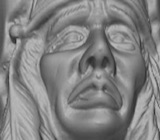Photometric Stereo
Photometric Stereo for Dynamic Surface Orientations: We present a photometric stereo method for non-rigid objects of unknown and spatially varying materials. The prior art uses time- multiplexed illumination but assumes constant surface normals across several frames, fundamentally limiting the accuracy of the estimated normals. We explicitly account for time-varying surface orientations, and show that for unknown Lambertian materials, five images are sufficient to recover surface orientation in one frame. Our optimized system implementation exploits the physical properties of typical cameras and LEDs to reduce the required number of images to just three, and also facilitates frame-to-frame image alignment using standard optical flow methods, de- spite varying illumination. We demonstrate the system’s performance by computing surface orientations for several different moving, deforming objects. (with Hyeongwoo Kim and Bennett Wilburn). [Paper PDF]
Ultra High Resolution 3D Imaging: We present an imaging framework to acquire 3D surface scans at ultra high-resolutions (exceeding 600 samples per mm2). Our approach couples a standard structured-light setup and photometric stereo using a large-format ultra-high-resolution camera. What is unique to our approach is the significant asymmetry in the resolution between the low-resolution geometry and the ultra-high-resolution surface normals. To deal with these resolution differences, we propose a multi-resolution surface reconstruction scheme that propagates the low-resolution geometric constraints through the different frequency bands while gradually fusing in the high-resolution photometric stereo data. (with Lu Zheng, Yu-Wing Tai, and Michael S. Brown). [Paper PDF]

